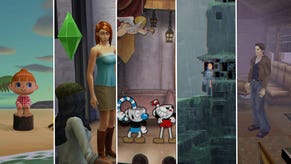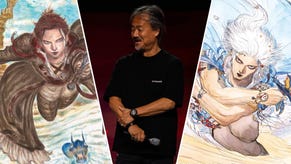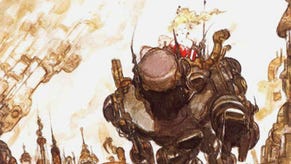The Final Fantasist: A Conversation With Yoshitaka Amano
COVER STORY: The artist who has given life to so many Final Fantasy games speaks about his inspirations, the difference between fine and commercial art, and his current projects.
This article first appeared on USgamer, a partner publication of VG247. Some content, such as this article, has been migrated to VG247 for posterity after USgamer's closure - but it has not been edited or further vetted by the VG247 team.
USG: So the process of taking this sculpture back here from a 3D wireframe to a physical object, what process did you use for that?
YA: I actually worked with a professional. This person is in the car industry, so basically, I made the original and then worked with a professional to create it into this sculpture.
USG: So this isn't simply a 3D print, it was actually instructions you gave to an industrial designer to build from?
YA: That person actually took the 3D data and used a 3D printer to create this. With the data, you can make it this small or you can make it even bigger than this. So I talked with the person who created the 3D sculpture of this and decided, OK, let’s make it three meters. The process of deciding this and describing it — I feel like this is art. With just one set of data, you can make it super tiny or super gigantic, and that’s what I feel contemporary art is.

USG: Yeah, the process you’re talking about is very similar to the ones used to make things like toys or even design game consoles or automobiles so it’s really kind of skirting the boundaries between art and mass manufacturing in commerce. Do you think that’s just sort of the natural direction of art? Is there a line between what you do and mass manufacturing besides just the number of items you’re producing?
YA: It’s exactly the same. The one thing that’s different is that the [contexts] are different. So when the work is introduced on a different stage, it's received in a totally different way and is received by a totally different audience. That’s probably the only difference — otherwise, what you do is actually exactly the same.
USG: So you’re with Marcel Duchamp—art is mostly just about presentation?
YA: Yes, I agree. With games, I feels like I'm a part of something bigger, so I'm helping the product out. If it doesn’t sell—like, let’s say I do a really good job with the art, but if the game doesn’t sell, that just means that the game is not received well. But with art, the art itself is one product, and that means everything. Games have different meanings and different layers and different ways of being received, but with art, you just have this one thing, one item, one existence, and one meaning to it. I'm the sole creator of my art, so I have more responsibility towards it, and I'm responsible for how it's received. So I really feel like those two concepts, art and product, are very different.
USG: So where do you stand on the debate over whether or not video games can be art?
YA: I feel that games can become art. When I'm involved with a game project, that’s what my approach is. What I'm doing is drawing the original image, and then someone will take that original image and integrate it into the work. Games can become art.
With movies, you are only able to watch. But with a game, you can be a part of the world. With the VR technology, you could literally go inside the game world — and there's another thing. Work that wasn’t even viewed as art in its own time, after time, it turns into art, too. If you go to the Louvre, you will see a lot of Christian paintings, and those were not made as art back in the day. But after history gets added to it, it turns into art. Games, too, can turn into art after a while, as well, in the same manner.

USG: You said that one of the things that kind of differentiates art that you create in video games is that video games are a collaborative process, that there are more people involved. But obviously, you’ve collaborated with the sculpture here. You didn’t do that entirely by yourself, you worked with someone. Where do you draw the distinction?
YA: The difference would be that... with Final Fantasy, Square Enix will approach me and ask me to do something, or ask, "Can you create an image of this game?" But with something like my own work, I become motivated to create something on my own. That's the biggest difference. Of course, there are other elements, too. On the other hand, what I put into it, how I face the job itself, is not that different whether it's a commission or my own work.
USG: Have you ever considered creating your own video game?
YA: The way I come up with my creations is that first I'll draw a character. From there, I start thinking about the story that surrounds this character — what kind of atmosphere does this character live in? — and that’s how story gets built around the character. If you turn that into a visual, that could become a movie, and so that could then be turned into a game. It could be the story for the game, or the setting. But I'm not a professional game creator, and I doesn’t know how to create a fun game, or what kind of game system will go along with the atmosphere I've created. There are a bunch of professionals out there who can do that, and I don’t feel that that it's something I would do.
USG: Do you follow video games at all? I know you’ve been pretty heavily involved with Final Fantasy and other games, but I’m curious as to whether actually you do much gaming yourself. If you got into working with Square because of your love for video games or was it some other reason?
YA: I used to play games a lot, but I haven’t been playing too much... at least, I haven't been playing console games. There is this game I've trying out, but I can’t say which it is — it’s still a prototype and it’s not out yet. I've been playing that game, though, and I can see myself getting into that and playing games more... this is a mobile title, so I've been playing on my phone. Because of that game, I can definitely see myself picking up games again on my phone. Everyone lately is playing games on their phone, even small kids, four or five years old. They have their devices and playing their games, and I'm sure I could too.

USG: Have you had a chance to try out Hironobu Sakaguchi’s latest game, Terra Battle? I know you've contributed some art to it.
YA: Yeah, I've played it a little bit. Sakaguchi-san showed it to me.
USG: The idea behind that—the "download starter"—sounds really interesting. I’m curious—have you ever been involved with anything along those lines, or is it a new experience for you?
YA: Actually, yes, I have been involved in this kind of project, but again I can’t really talk about it yet. I have a grandchild who is five years old and is already playing games, so I feel like the future for gaming is really big. Even kids who don’t know how to read are playing games and... for us, picking up a picture or opening a picture book might have been our first interaction with visual media. But kids nowadays, games are the first visual thing they interact with, and that means the future for gaming is really big.
USG: So, as a visual artist, what do you think that means for the future of your work?
YA: There's a project I've been creating lately called Candy Girl. I created this character, and now they’re creating the 3D model of the character, and I'm collaborating with a lot of partners, like fashion partners and music partners, to create a song for her. They are also creating a promotional video for this character... so there might be future collaborations to possibly create a game for her. My path may cross with gaming in that way. This whole project—there is the kawaii culture, the culture of cute, here in Japan. So as a part of this larger pop culture, Candy Girl is collaborating with a lot of different media right now.

USG: What was the genesis of that project?
YA: During the ’70s, I created a bunch of animation characters, and that’s where I'm getting all my inspirations from. Kawaii culture, that is kind of a boom now, not just here in Japan but outside of Japan too — it's big in France as well. But I'm not too concerned about what’s going on outside in the world or what’s "in" right at this moment. I just have a certain inspiration, and I love drawing, and drawing, and drawing. It's not that anyone has asked me to make this type of work... I'm just really into creating. Right now, I'm really into drawing Candy Girl, and [working on the panther sculpture]. With Candy Girl, if you put a story to this, this will turn into an anime or a movie. If you have her sing something, she will turn into a virtual idol. But I'm not the person to bring her into other media. What I do, what I enjoy, is creating the origins. Then I leave the rest of the work to other professionals, who can bring it to different media.
USG: Candy Girl is very different from a lot of work I see from you. Your work has a tendency to be sort of ethereal and surreal, while this has very bold, strong colors. It’s very flat pop art. It’s an interesting style.
YA: It's different from my Final Fantasy style. I'm always drawing, so I have to work in different styles or I'd just get bored.














